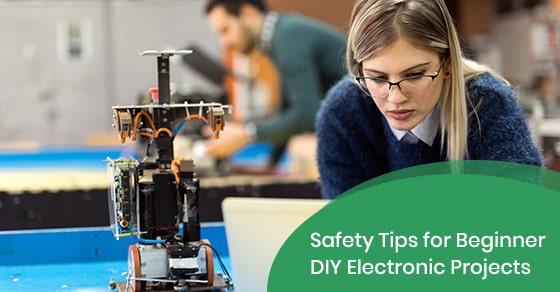Safety Tips for Beginner DIY Electronic Projects
The electricity generated from mains voltage can be very dangerous and may even cause death by electrocution. The electricity that is not fused and cabled correctly may also lead to explosions and massive fires in some cases.
Therefore, there are many risks that you need to be aware of if you are planning on tackling DIY electronic projects. For most people, contacting electronic manufacturing services in Toronto would be the ideal way to get a project up and running. If you want to tackle your electronic project yourself, follow the tips below.
How to Avoid Mains Electricity
If you want to reduce the risk of electrocution drastically, you should avoid utilizing mains voltage in a CPU (central processing unit) circuit. Most circuits can be powered via an external plug-in transformer or can be activated by using a few spare batteries, as most electronic circuits are low-voltage devices.
The ideal way to handle transformers is to use either a plug transformer or a power-adaptor/power-brick, such as the ones that are commonly used with most laptops.
Isolate from the Mains While You’re Working
If you plan on working with an appliance or unit with explicit warning labels on them, such as “Do Not Remove Cover Due to High Voltage,” or “Disconnect the Mains Supply Before You Remove the Cover,” then you should pay heed to such warnings.
Equipment with such labels may have mains voltages in the interior that are unprotected, which may serve as a safety hazard. If you have opted to extract a cover from a mains electricity unit, it would be best to set the lid back in place before connecting it back to the mains unit.
Case Earthing is Paramount
If you decide that you want to work with mains voltage while working, then you should remember to earth the case and use a metal case if possible. The earthing of a case can be done by extracting a sturdy wire from the earth terminal and affixing it to a metal section of the case that has been exposed.
In some cases, your metal case may come equipped with a specialized connector so that you can easily connect to the earth. However, if your metal container does not contain such a container, you can solve it by connecting the earth to a metal-based screw that will hold all the case components together.
In addition, proper diagnostics should be run to ensure that all of the case components, as well as the metal, is earthed as intended.
Use Insulated Leads
One of the most important things to remember before you affix any appliances or devices to the mains voltage is to make sure that the device’s leads are in optimal condition, and that there is no visible damage to the unit. Even store-bought cables should be inspected, as they can break down over time, especially if they have been incorrectly stored.
Live equipment testing should also be avoided whenever possible. However, if you must perform live tests, ensure that the test leads have been effectively insulated and that the voltage under test also has the required amount of insulation.
How to Isolate Mains Voltage
It is usually rather simple to shut down power by pulling the plug when working with homemade projects or electrical devices. However, in the case of appliances and home wiring directly from the mains, as is the case with burglar alarms, the mains electricity may be affixed directly into the unit.
In such a scenario, a fuse panel or switch will usually be placed on a wall where it connects, so the electricity should be isolated from there to play it safe.
Why RCDs are Recommended
Residual Current Devices (RCDs) can help provide additional protection against the risk of a severe shock. They are designed to disconnect the supply if someone is being electrocuted, or if the unit detects a fault. Unfortunately, RCDs may not be available in certain areas, but they are included in house wirings in domestic domiciles in the United Kingdom.
As such, if your home is located in Canada or the United States and does not include one, you can buy an RCD adapter from a hardware store that can be plugged into the main socket. All you need to do is plug your equipment that is being powered by the mains into the adaptor.
Work with Someone
When working on a project that you are not familiar with, we recommend that you work with someone who knows what they are doing. At the very least, working with someone will ensure that you can get help if something goes wrong. We would also suggest that you and your partner learn CPR and first aid to take care of the other while the paramedics arrive.
How to Reduce the Risk of a Fire
A fire may ensue if a plug socket becomes overloaded, as an overloaded socket may overheat in time. Or, a very high current may go through a particular wire or component, which may also result in a serious fire if left unchecked.
Fortunately, a quick and easy way to reduce the risk of a fire is to use the right fuse. The correct size fuse should be used, and the selected fuse should be above—but as close as possible—to the maximum current that the circuit in question will draw.
Moreover, any items that can get hot very easily should be kept as far away from flammable liquids or materials as possible. For example, light fittings should be moved away from your curtains, as a draught can blow them if you leave a window open during the summer.
Circuits-Central
If you require excellent electronic manufacturing services in Toronto, then please visit our website. With over 20 years of experience, Circuits-Central provides full electronic manufacturing services and can be reached at 416-285-5550 or 888-821-7746 for any business or service inquiries.

